


xxxxxIt was in 1642 (C1) that the Dutch navigator Abel Tasman discovered New Zealand. The English explorer James Cook claimed the islands for Britain in 1769, but it was not until the 1820s that the British began to settle in large numbers. This brought them into contact and contention with the indigenous people, the Maori, and to stop open conflict the Treaty of Waitangi was signed in 1840. This promised to protect the Maori, their rights and land, but, at the same time, it made New Zealand a colonial possession. This had the effect of increasing the number of settlers and raising the demand for land. When eventually the Maori refused to sell more of their land war, broke out, first in 1847-
THE TREATY OF WAITANGI 1840 (Va)
Acknowledgements
Map (New Zealand): licensed under Creative Commons – commons.wikimedia.org/wiki/File:NZ. Treaty: a stained-
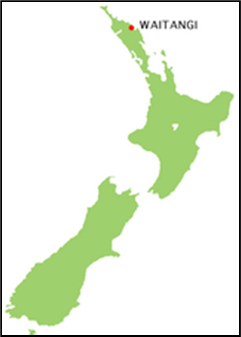 xxxxxAs we have seen, it was in 1642 (C1) that the Dutch navigator Abel Tasman discovered New Zealand. He sailed north along the west coast of the South Island but, facing opposition from the native Maori, did not land. It was not, in fact, until 1769 that Captain James Cook visited the islands and claimed them for the British crown. By that time it is estimated that well over 100,000 Maori inhabited the main islands, the vast majority having settled in the warmer North Island.
xxxxxAs we have seen, it was in 1642 (C1) that the Dutch navigator Abel Tasman discovered New Zealand. He sailed north along the west coast of the South Island but, facing opposition from the native Maori, did not land. It was not, in fact, until 1769 that Captain James Cook visited the islands and claimed them for the British crown. By that time it is estimated that well over 100,000 Maori inhabited the main islands, the vast majority having settled in the warmer North Island.
xxxxxIt is thought that the Maori, a Polynesian people, arrived on the North Island -
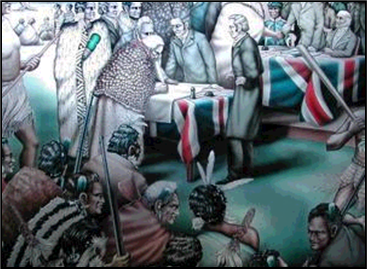 xxxxxInx1839 the British government appointed a naval officer, Captain William Hobson (1792-
xxxxxInx1839 the British government appointed a naval officer, Captain William Hobson (1792-
xxxxxBy the letter of the law, the Maori received the protection they needed but, in reality, the treaty led to a marked increase in British immigration, and a consequent worsening of their position. New settlements were established around the coast, such as Christchurch and Dunedin, and the town of Wellington was founded, the colony’s future capital. This expansion led to further encroachment upon Maori lands -
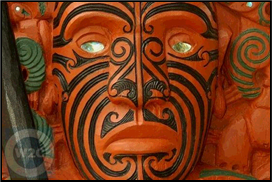 xxxxxIn 1852 an act was passed providing the colony with representative government, but the Maori were given no voice in the country’s administration, and by then much of their land (and the unique way of life that went with it) had been bought up by the crown and sold to the colonists for profit. In 1860 conflict broke out again, this time on both islands. The main cause was the increasing reluctance of the Maoris to sell their land, and the pressures placed upon them by new arrivals. Adopting guerrilla tactics, they continued a campaign of varying violence against the settlers throughout the decade. At Orakau, for example, in 1864, 300 Maoris held out for three days against a British force six times its size, and at one time they even attempted to create their own state (the so-
xxxxxIn 1852 an act was passed providing the colony with representative government, but the Maori were given no voice in the country’s administration, and by then much of their land (and the unique way of life that went with it) had been bought up by the crown and sold to the colonists for profit. In 1860 conflict broke out again, this time on both islands. The main cause was the increasing reluctance of the Maoris to sell their land, and the pressures placed upon them by new arrivals. Adopting guerrilla tactics, they continued a campaign of varying violence against the settlers throughout the decade. At Orakau, for example, in 1864, 300 Maoris held out for three days against a British force six times its size, and at one time they even attempted to create their own state (the so-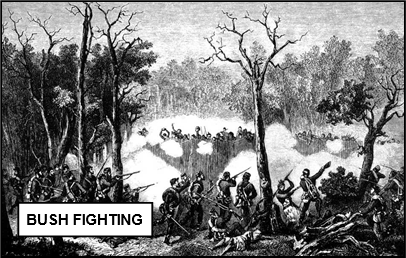 itted themselves well, and throughout the 1860s the government was obliged to moderate its land policy and adopt a more conciliatory attitude towards the native population. The Native Land Act of 1862 permitted the private purchase of Maori land -
itted themselves well, and throughout the 1860s the government was obliged to moderate its land policy and adopt a more conciliatory attitude towards the native population. The Native Land Act of 1862 permitted the private purchase of Maori land -
xxxxxOver the next forty years the country’s economy became mainly based on sheep farming, and this industry received an enormous boost in the early 1880s with the introduction of refrigerated ships. This enabled the export of fresh meat worldwide. In 1907 New Zealand was officially designated a dominion.
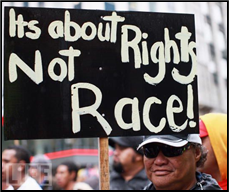 xxxxxIncidentally, the Treaty of Waitangi contained the seeds of future trouble. The translation of the terms of the treaty led to a great deal of misunderstanding, particularly as the Maori language had no real equivalent for the word “sovereignty”. Several chiefs refused to accept the agreement, and it would seem that those who did sign still believed that they were the guardians or “owners” of their land. This added to the Maori’s discontent, but it was not until the Treaty of Waitangi Act of October 1975 that a measure of financial compensation was given to certain Maori tribes for what they saw as an unlawful loss of their former territory. Then in 1989 the legal equality of the Maori people was confirmed by the New Zealand government. ……
xxxxxIncidentally, the Treaty of Waitangi contained the seeds of future trouble. The translation of the terms of the treaty led to a great deal of misunderstanding, particularly as the Maori language had no real equivalent for the word “sovereignty”. Several chiefs refused to accept the agreement, and it would seem that those who did sign still believed that they were the guardians or “owners” of their land. This added to the Maori’s discontent, but it was not until the Treaty of Waitangi Act of October 1975 that a measure of financial compensation was given to certain Maori tribes for what they saw as an unlawful loss of their former territory. Then in 1989 the legal equality of the Maori people was confirmed by the New Zealand government. ……
xxxxx…… The date of the Treaty of Waitangi, the 6th February, is commemorated annually throughout New Zealand. The first “Waitangi Day” was held in 1934, and it was made a public holiday in 1960. ……
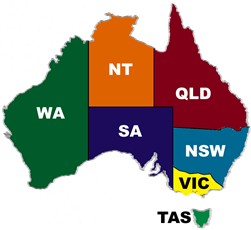 xxxxx…… The picture above showing the signing of the treaty is a stained glass window in the Maori Arts and Crafts Institute at Rotorua. The Maori sculpture is from Waitangi. ……
xxxxx…… The picture above showing the signing of the treaty is a stained glass window in the Maori Arts and Crafts Institute at Rotorua. The Maori sculpture is from Waitangi. ……
xxxxx…… It was during this period (1855) that Britain granted self-
Including:
The Maori Wars
1845-

Va-


